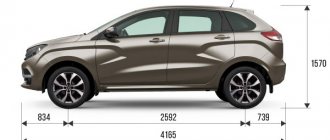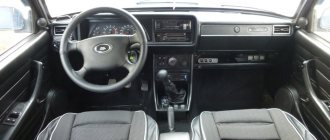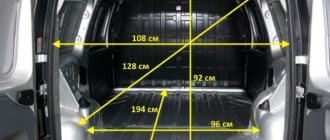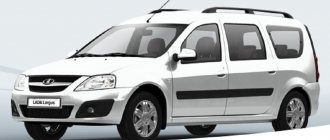Lada Largus is a family of the market niche “multi-purpose universal vehicles” (MPV) and the first joint development of AvtoVAZ and the French-Japanese alliance Renault-Nissan. The car is produced in the body of a van, compact van, station wagon and pseudo-crossover). The entire Lada model range.
Although the model is new for Russia, in reality it represents only a slightly transformed (based on the words of the AvtoVAZ company - adapted to domestic conditions of use) French-Romanian Logan MCV/VAN. The first Largus model left the conveyor plant in Tolyatti on June 17, 2011.
But serial production of the vehicle started only in April 2012. It is worth noting that the domestic version of the MPV quickly became one of the most popular Lada cars on our market. But the official history of the practical car began earlier – at the end of 2010. During the Moscow Automobile Salon, a car was presented under the code name “Project R90”.
The first mass-produced Lada Largus car with the number “000001” turned out to be unusual. Russian President V.V. Putin put his signature on its hood. and representatives of Renault and Nissan.
Appearance
If you turn your attention to the appearance of the Lada Largus station wagon, you can easily recognize in it an exact resemblance to the Dacia/Renault Logan MCV of the 1st family, except for small elements. Most similarities with the Tolyatti brand can be seen on the front of the vehicle. And it doesn’t matter who is in front of us - the passenger version or the Largus van.
The chrome horizontal line that crosses the grille rests on the . On top of that, the front part has modest optics and a bumper with soft patterns and an air intake “mouth”. The front headlights look quite modest. The luxury version allows you to install fog lights in the black recesses.
Lada Largus is the most spacious Russian passenger car. The name of the car was also not invented in vain - translated from Latin it means “generous”.
If you look at the car from the side, it looks like the most ordinary station wagon from another manufacturer. There is a sloping hood, a flat roof and large side glazing. The side repeats the design up to the edge of the doors of the 2nd row of the Renault Logan sedan. The wheelbase turned out to be stretched.
Lada Largus belongs to the station wagon division and over the entire period since the start of sales and use, the car has received a considerable number of good reviews. The ride height is 175 millimeters, which should be enough for everyday use. However, you need to be careful when traveling over rough terrain, especially if the car is loaded. The remaining sizes of Largus allow the station wagon to be used in many areas of life.
The rear of the Lada Largus 2022 received a huge cube-shaped stern. The stern looks quite normal. There are two asymmetrical hinged doors that go deep into the bumper and lighting columns, made neatly. The specialists did not forget to equip the car with a low loading height, which makes loading/unloading luggage much easier.
A rear wiper and heated glass function are provided. The appearance of the Lada Largus has hardly changed, if you do not take into account the new off-road versions. Interestingly, the 2nd Logan MCV family has already been presented to Romanian car enthusiasts. It is worth recognizing that the appearance of a new product in the near future in Russia is unlikely.
Perhaps they will decide to update the car a little and not earlier than the end of 2018. Based on the words of the manufacturer, the car will have some attributes of the new corporate style from Lada Vesta and XRay.
Salon
The interior of the 2022 Largus is almost no different from the same Logan. The salon is ascetic and unremarkable. When viewing the dashboard and other elements, you can see existing ergonomic mistakes that were still characteristic of Logan. “Tidying” turned out to be laconic. There is a two-color on-board computer display and an instrument dial with a chrome trim.
The entire dashboard is informative and does not distract the driver from driving. The steering wheel turned out to be large and fixed on 3 spokes, and also has height adjustment. In the center there is a Lada nameplate. The number of controls on the center panel is limited. The maximum configuration has a radio that supports AUX and USB connectors .
The entry-level and mid-range versions received a simple plastic plug instead of the radio. Near the plug there are controls for the ventilation system and heating (there is an air conditioner and a stove). Between them are the keys for the electric drive of the windows installed on the front windows. There is also a rear door lock, heated rear window and hazard warning lights. The center console itself has a metal trim.
This car became the first joint project of AvtoVAZ and the French-Japanese alliance Renault-Nissan.
As for the interior upholstery of the Lada Largus, hard plastic and fabric were used in its manufacture. Seating provides only a minimum level of comfort. The seats installed in front turned out to be flat, there is lateral support, but it is minimal. But the arsenal of settings for the front seats turned out to be large.
The luxury version boasts driver lumbar support and seat height adjustment. The round air ducts of the ventilation system are edged with metallized rings. Passengers in the second and third rows will not feel discomfort due to the lack of free space. Three adult passengers will be pleased with the air ducts provided for them.
The roof does not cause depressing thoughts, but it is worth noting that getting into the 3rd row of seats is not very convenient. However, it is important not to forget that the car was created to transport goods and passengers on a budget basis. A car shouldn’t be too comfortable, but it performs its main tasks well.
Despite the cheap interior and upholstery, everything is made quite well and robustly. If there are any extra noises or squeaks from poorly fixed parts, they are not very disturbing, as in other cars of this niche.
The trunk volume of the five-seater Largus model is 560 liters. This is the best result among station wagon B-class cars officially available in Russia (as of 2014).
I would also like to say something about the trunk of the Lada Largus 7. The modification of the car with 5 passenger seats has a volume of usable space of 560 liters. If you fold the rear seats, the volume increases to 2,350 liters. It turns out that you can transport furniture, refrigerators and other large items without much difficulty.
The passenger version with seven seats has 198 liters of volume, as well as the ability to easily remove the rearmost row. This allows you to use the car as a cargo truck and have the same spacious luggage compartment. A full-size spare wheel is located under the bottom, and the tailgate can be opened in two asymmetrical parts by 180 degrees.
The Lada Largus Furgon modification has a volume of 2,500 liters and can carry 800 kilograms of cargo. The data is very impressive. There is nothing better for summer residents, gardeners and small businesses.
Interior dimensions of Lada Largus
The general dimensions of the car were discussed above; the equipment also has features in the arrangement of interior elements. The interior design and arrangement of multimedia and security systems have several options - for 5 and 7 seats. Internal dimensions of the Lada Largus assembled at AvtoVAZ:
- The distance from the trunk to the windshield is 3140 mm.
- The length from the front panel to the tailgate is 2700 mm.
- Diagonal (from corner to corner) – 3240 mm.
- The width in front of the rear seats is 1430 mm.
- The width in the third row of seats is 1290 mm.
The Largus interior has optimal dimensions for cars of this class, which ensures a comfortable ride for 5 adult passengers. The overall dimensions of the Lada Largus allow you to take a load of 550 kg.
Specifications
Power unit
The cargo-passenger version of the Lada Largus has two naturally aspirated four-cylinder gasoline engines. The “standard” role is played by the 1.6-liter VAZ-11189 power plant, which received a distributed injection system and an eight-valve gas distribution mechanism. All this allows the Lada Largus to produce 87 horsepower and 140 Nm.
This “engine” allows you to accelerate to a speed mark of 100 kilometers per hour in 14.4 seconds. The maximum speed does not exceed 158 kilometers per hour. The 83-horsepower engine consumes about 8.2 liters of gasoline per 100 kilometers.
More expensive configurations already have a 1.6-liter VAZ-21129 engine, which received multi-point power and a sixteen-valve timing mechanism. The 16-valve Largus already produces 106 “horses” and 148 Nm. It takes 13.5 seconds to reach the first hundred, and the “maximum speed” is 165 kilometers per hour. In combined mode, the power unit requires about 7.9 liters of fuel per 100 km.
Although this station wagon was not updated externally after its release, it was always improved technically. For example, in December 2015, the car was equipped with an 87-horsepower power unit instead of the “French” Renault K7M with 84 horsepower. After August 2022, instead of the 102-horsepower Renault K4M, they began to install a Russian power plant designed for 106 horsepower (the engine was produced by the VAZ plant).
Transmission
All engines work only with a 5-speed manual gearbox. All torque is transmitted only to the front wheels.
Chassis
This vehicle is based on the front-wheel drive platform B0 of the Renault-Nissan association. There are standard McPherson struts up front and a semi-independent U-beam at the rear. The steering device has a rack-and-pinion design and is complemented by a hydraulic power steering wheel (the basic configuration does not have a hydraulic power steering).
The braking system is equipped with ventilated disc devices at the front and drum mechanisms at the rear. The electronic ABS system is not supplied only for the standard version; all other configurations already have it by default.
Safety
The Lada Largus 2022 station wagon is a modern car, so experts have not ignored the practical model in terms of safety. There is a latest generation anti-lock braking system. The power frame of the body was designed to minimize bodily injury to passengers in a collision.
All seats have three-point seat belts and head restraints. The driver and front passenger have front and side airbags. Lada Largus 2022 fully complies with current European requirements for passive safety. This is availability:
- Driver and passenger airbags;
- Front seat belts with force limiters;
- The front subframe acts as an additional side member, absorbing and redistributing the energy of a frontal impact;
- Three-point seat belts and head restraints;
- Anti-lock braking system;
- ISOFIX child seat mounting systems;
- Indication of unfastened driver's seat belt;
- Honeycomb inserts in front door panels;
- ERA-GLONASS systems.
Van F90
In addition to the standard station wagon, the model has a van body designed for cargo and passenger transportation. A van marked F90 differs from a station wagon in that it has a greater load capacity and has solid rear and side panels. The dimensions of the F90 are similar to the station wagon, with the exception of some points:
- The height of the van is 1650 mm (with roof rails – 1686).
- The trunk is significantly expanded, its volume is 2540 liters.
Today, the line of cars continues to develop - there is already a Cross (SUV) option and a CNS (gas) option. In any configuration, the Largus family offers budget-class vehicles that are convenient for transporting cargo and daily use.
Crash test Lada Largus
The station wagon can hardly be called a new car. For those who have already bought this car, its pros and cons are known. However, those who are just thinking about buying this model may be confused. Perhaps crash tests of Lada Largus will help get a more objective picture.
Like all vehicles, the Lada Largus station wagon underwent mandatory crash tests. During a side test, a special trolley crashed into the car at a speed of 50 kilometers per hour. The car performed quite well in such a test. Due to the damage, the car doors could not open.
The dummy, which was inside the car at the time of the study, received damage to the head 8 times lower than allowed. If we talk about pelvic injuries, then here too Largus copes with the assigned tasks, meeting these standards threefold. If we talk about damage to the car after being hit from behind, then Largus did not disappoint here either, since it provides excellent protection against unnecessary injuries.
During the impact with the movable barrier at a speed of 36 kilometers per hour, the interior remained intact and the seats were secured. It is also interesting that the side windows, along with the glass of the rear trunk door, were not damaged. The fuel tank is perfectly protected by the spare tire and suspension parts. That is why during a crash test it remains unharmed.
Tests of the Lada Largus station wagon have shown that the car meets all legal safety requirements. Crash tests were carried out under more difficult conditions. The established rules for a frontal collision indicate an impact at a speed of 56 kilometers per hour, and the VAZ was tested at a speed limit of 64 km/h, which is 8 kilometers per hour more than the norm.
After the tests, the car received 8.32 points out of 10 possible, which is an excellent result, comparable to the Logan MCV, which received 8 points in 2005. It turns out that you can and even need to buy a Lada Largus station wagon.
Transmission and suspension
At the moment, the Largus Cross 5-seater car is equipped with five-speed manual transmissions of the JH3 540 and JR5 549 type. There are also 2 variations of gearboxes for the 7-seater Largus: JR5 551 and JR5 517. Each type of transmission works in tandem with a specific engine.
The French JR5 gearbox is installed on cars equipped with a more powerful 105 hp K4M engine. s., and the JH3 manual transmission is equipped with an 84-horsepower unit. These boxes are used not only on Largus, but also on other VAZ models (Vesta, X-Ray). In order to find out which gearbox the Largus Cross is equipped with, you need to look at the table located at the bottom of the crankcase.
These boxes have no fundamental differences in design. Different components are used to disengage and engage the clutch, and slightly different mechanisms are used to change gears. The units that attach the front axle drive are also slightly different. I'm pleased with the selector lever of the manual transmission. Shifts are made smoothly and the lever stroke is smooth.
French mechanics are also far superior to previous domestic developments in terms of operating sound. The Renault gearbox is quieter and does not emit as much howling and hum as was inherent in the cable mechanism of previous Lada models. But the operation of the box can still be heard. If the noise increases over time, it is more difficult to combat it in the Largus station wagon 5 seats, since the use of transmission oil is not provided. During manufacturing, transmission fluid is poured into the gearbox mechanism, which does not need to be changed during the entire service life.
The suspension of the cross-country version is provided as follows. An independent structure is installed in front; the shock absorber struts operate hydraulically. The system is also equipped with helical coil springs.
The operating principle of the front suspension is a lever suspension, with stamped arms and a stabilizer, which are fixed to the subframe structure. It is made using stamping and welding. It has a box-shaped section and is attached to the side members at the front and to the front end panel at the rear.
The rear suspension is semi-independent. The principle of operation, unlike the front one, is using levers and springs. The trailing arms are attached to the body using hinges and connected transversely to each other by a torsion beam, inside of which the stabilizer is located. Silent blocks connect the trailing arms to the car body. Rubber gaskets are inserted at the ends of the springs.
As you can see, the Largus station wagon 5 seats is a well-equipped car, while AvtoVAZ’s pricing policy for Largus is acceptable for most Russians. Due to this, the station wagon is one of the leaders in its segment on the domestic market.
Options and prices
For the Russian market, Lada Largus 2022 is offered in 3 trim levels: Standard, Norma and Luxe. The “Standard” assembly costs 524.5 thousand rubles and has an eight-valve K7M power unit with a 5-speed manual JH3 gearbox, as well as:
- Driver's airbag;
- Seat belts for the driver and passenger sitting next to them with a limiter function;
- Clips for child seats;
- Vacuum booster of the brake system;
- Mechanical optical lighting corrector;
- Inertial seat belts (5 pieces);
- Head restraints on the rear seats;
- Locking doors from opening by children;
- Immobilizer;
- Fabric seat upholstery;
- Plastic upholstery;
- Brushed carpets in the cabin and trunk;
- Bracket for securing cargo;
- Adjustable steering wheel tilt;
- Lighting in the trunk;
- Alarm indicating that the side lights are not turned off;
- Single ignition and door key;
- Audio preparation;
- Stamped 15-inch “rollers”;
- Electronic systems ABS and EBD;
- 12-Volt socket;
- Cabin air filter;
- Light tinting;
- Railings
- Full size spare wheel.
Next comes the performance “Norma”, which is estimated from 544,000 rubles. It has:
- Sun visor with mirror for the front passenger;
- Possibility of folding the passenger seat in a ratio of 60:40;
- Hydraulic power steering;
- Seat belt height adjustment;
- Central castle;
- Electric windows on the front windows;
- Bumper painted in the same tone as the body;
- Moldings on the side doors.
The “Norma” version has additional packages of “Climate” and “Control” options. The price will be higher – 566,000 and 601,500 rubles, respectively. In “Climate” you can see the presence of air conditioning and heated front seats. The Comfort has already installed an airbag for the front passenger with a function to turn it off, a luggage rack, a curtain shelf in the trunk, as well as an audio system with a pair of speakers.
The “Lux” version has already received:
- Sound signal in 2 tones;
- On-board computer;
- Fabric inserts on door trim;
- Chrome elements in the interior trim;
- Leather trim of the “steering wheel”;
- Ability to adjust the driver's seat with lumbar support in height;
- Cigarette lighter with ashtray;
- Pockets on front seats;
- Central locking with remote control;
- Power windows on rear windows;
- Exterior mirrors with electric drive and electric heating function;
- Painting door handles and mirror trims to match the body paint;
- Thresholds on the front doors;
- Fog lights;
- 15-inch cast “rollers”;
- Audio system with four speakers;
- Front and rear parking sensors;
- Parktronic.
For this option you will have to pay at least 633,700 rubles. There is also a model that received stamped rather than cast wheels. For this you will need to pay an additional 10,000 rubles.
Review of LADA Largus station wagon
LADA Largus station wagon. Will take over everything
LADA Largus station wagon is an outstanding capacity and high quality workmanship, increased ground clearance and special body protection.
For traveling. For work. For a thousand things
LADA Largus station wagon is a comfortable and roomy car for the city, active countryside recreation and business trips.
It is created as a universal transport capable of performing many tasks “excellently”.
Interior: convenience in every detail
Thanks to the sophisticated power structure of the body and modern safety systems, the LADA Largus station wagon meets the current European requirements for the protection of the driver, passengers and pedestrians.
The station wagon's interior is practical and comfortable: large buttons, good-quality handles, durable fabric. These qualities are emphasized by the general style of the interior, in which silver elements are used.
Practicality and comfort in every detail
LADA Largus station wagon is ready to please passengers with comfortable wide seats. The driver's seat is equipped with height adjustment and lumbar support - this provides a comfortable fit for the driver of almost any size.
LADA Largus is unique in that truly comfortable seats have been created for passengers in the third row: passengers above average height feel free here. LADA Largus is perfectly adapted to the Russian climate: each of the three rows of seats is equipped with air ducts for heating the feet.
Functionality beyond the usual
The name Largus means “generous” in Latin, which speaks of the car’s wide capabilities. LADA Largus offers many options for transforming the interior.
Safety by design
Thanks to the sophisticated power structure of the body and modern safety systems, the LADA Largus station wagon meets the current European requirements for the protection of the driver, passengers and pedestrians.
Airbags
Two front airbags - essential protection for driver and passenger
ABS+BAS braking system
The ABS system reduces the braking distance of the vehicle and maintains controllability during emergency braking.
ERA-Glonass
Emergency warning system in case of accidents. Works even if the battery is disconnected
Rear parking sensors
Reliable insurance when maneuvering in reverse
Superiority Technique
Largus is not only a comfortable, energy-intensive suspension. LADA Largus station wagon is a dynamic car capable of solving many problems. When speed is required, it can accelerate quickly even when fully loaded. This is facilitated by specially selected gear ratios in the transmission. When the driver expects confident maneuvers from Largus, the car proves that it can obediently follow steering movements. Reliability and versatility – this is the philosophy of LADA Largus.
Modern economical engines
There are two engines available for LADA Largus, which allow you to choose a car to suit your taste and goals. Powerful and dynamic, 1.6 l (106 hp), 16-valve engine - for high-speed driving, and high-torque, 1.6 l (87 hp), 8-valve - the optimal solution for economical movement of heavy objects .
Tuning
The Lada Largus turned out to be a practical model and from the start of sales it became a great success among car owners. The car has good build quality, but the appearance is not the best. The domestic car gave priority to rigor and practicality in favor of a stylish design. Therefore, many Lada Largus car owners will decide to improve their appearance using tuning.
Improving the power unit
When considering options for tuning a Lada Largus car, it is first advised to concentrate on the technical part. Special attention should be paid to the power unit. The “engine” can develop from 84 to 102 “horses”, depending on what design solutions are used in this car.
For daily trips in an urban environment, the engine power is enough, especially if you have a family. But there are many Lada Largus owners who are not satisfied with the capabilities of their engine. Therefore, there are 2 ways to improve the power of your power plant:
- Perform chip tuning on the electronic control module, followed by changing the settings;
- To carry out modifications to the motor in the mechanical part, which involves productive intervention with the task - to replace the elements with similar components of a more reinforced plan.
If we talk about the first method - chip tuning, then it is quite common and is popular with many car owners. The purpose of the improvement is to change the ECU settings. As a result, it is possible to achieve engine adjustments. If you correctly calibrate certain parameters, you can expect a worthy reward - an increase in power.
Chip tuning is best done in specialized workshops. They can reprogram the standard firmware version to a different one. As a result:
- The fuel “appetite” decreases;
- Toxic emissions are reduced;
- Dynamic performance increases.
You can also resort to mechanical transformations of the power plant. This implies a significant improvement in performance (plus about 10-40 percent to the basic parameters). Such transformations are carried out by replacing some elements in the motor. This may include:
- Fuel supply system;
- Timing elements;
- Injection components;
- Elements of the cylinder-piston group and the block head.
It is important to note that parts must be replaced only with similar ones that are structurally compatible with the given engine.
Improvement of Largus body
If the owner of a Lada is not delighted with the appearance of the body, then you can transform the exterior of your “swallow”. Many people at this moment are inclined towards two options:
- Carry out structural modernization of body components;
- Make cosmetic improvements.
The first option involves replacing some body parts with newer ones. Often such elements receive an individual design. It is important that if you qualitatively and skillfully transform the exterior of the Lada Largus, you can improve its aerodynamics. Some drivers decide to:
- Installation of a spoiler;
- Installation of body kit on the hood;
- Replacement of front and rear optics with more modern ones;
- Installation of various reinforcing elements (front radiator grille, protective linings, skirts, etc.);
- Installation of newer “skating rinks”;
- Replacement of bumpers, external mirrors and other things.
Of course, such manipulations require the allocation of considerable funds and free time, but the result will please the owner for a long time. Simpler tuning includes cosmetic improvements to the exterior. Can:
- Renew body paint;
- Tint the windows;
- Make airbrushed designs on body panels;
- Glue the body with different polymer materials (carbon, vinyl, and so on);
- Use additional LED lighting sources.
Interior tuning
This may include:
- Replacing covers with new ones, with a more interesting design, or installing new seats instead of basic chairs;
- Covering panels with fresher materials;
- Replacing the “steering wheel” with similar options with a sporty twist;
- Installation of the armrest;
- Replacing door handles with similar ones with their own lighting;
- Application of noise insulation.
You can also install speakers, a subwoofer, a TV, etc., which increases the level of comfort. The improvement can also affect the suspension, through the use of reinforced parts, increasing or decreasing ground clearance, installing shock absorbers and stabilizers with increased data, etc.
Comparison with competitors
Although the Russian model Lada Largus 2022 does not have a huge number of rivals in its class, they still exist. The model will compete for the attention of consumers with Peugeot Partner, Citroen Berlingo, Renault Kangoo, and Volkswagen Caddy.
If we speak for Renault and Citroen, they received 460 liters more luggage space, so they remain in a significant lead. However, they do not have such a high load capacity. The Renault version has 3,000 liters of usable space including the rear seats folded, which is also quite a lot.
The load capacity is higher than that of Citroen and Peugeot, but the interior transformation options are clearly inferior. As for the German version of Volkswagen, it does not have an abundance of interior transformation options, but the trunk volume is 200 liters higher than its closest rivals. Despite the fact that the power plant is as economical as the French versions, the engine develops 20 “horses” more.
In terms of carrying capacity, the model is slightly inferior to the Lada, but the Caddy is the strongest, most spacious, equipped and diverse. Volkswagen even has versions with an all-wheel drive system. There was also a full-fledged crossover modification of the Cross Caddy.
Technical specifications
For the Lada Largus, the manufacturer has provided only two powertrain options. In both cases, the unit is equipped with an identical volume of 1.6 liters. Only the designs of the block heads and power indicators differ:
- The 8-valve version is capable of output of 84 hp. With.;
- The 16-valve version of the engine generates 105 horsepower.
In the maximum variation of equipment, the car can accelerate to a speed of 165 km per hour, and this is a decent indicator, as evidenced by the reviews of the owners. Fuel consumption in a city rhythm does not exceed eight liters. By the way, the manufacturer prescribes the use of 95 gasoline.
For the Lada Largus Cross, the only transmission unit option is available - a classic “mechanics” with five steps. The gear ratio of the final drive may vary in the box: in the “Norma” it is 4.5, and in the “Lux” it is 4.2.
The amount of space in the luggage compartment in its standard form is only 135 liters, but if you fold the backrests, it grows to an enviable 2350 liters.
Duster tire pressure
Renault Duster how many liters tank
Renault Duster do-it-yourself modifications video
The overall parameters of the station wagon we are considering are as follows:
- length – 4470 mm;
- width – 1750 mm;
- in height – 1636 mm.
And the main question remains, how much does this car cost?
Owner reviews
Based on reviews from Lada Largus owners, we can conclude that many drivers are happy with their car. The advantages of the model include good spaciousness, acceptable ride height, seven-seater option, low cost, reliability and spacious luggage compartment. The exception is versions with seven seats, where there is almost no space left for luggage.
I'm glad that there are roof rails for transporting various large cargo. Owners of Lada Largus note the convenience of rear hinged doors. The rear row of seats can be folded down. If necessary, you can even spend the night on it. There are massive external mirrors, which, unfortunately, do not have electric adjustment. The gearbox engages perfectly, smoothly and without jerking.
The lack of an on-board computer is a little frustrating, as there is a lack of useful information about this vehicle. The disadvantages include poor-quality assembly, an abundance of defects, imperfections, high fuel consumption, large dimensions and an equally large turning angle, a heater, low dynamics, a weak power unit and ergonomics.
The quality of the plastic leaves much to be desired. Handling and ride quality suffer. Owners of the Lada Largus station wagon do not like the low sound insulation, hard suspension and expensive maintenance.
Station wagon review
The start of mass production occurred in 2012. The basis for the construction of this universal model of 7 seats was the progressive “B0” platform at that time. The new station wagon quickly gained its fans, as it had a modern design and demonstrated enviable functionality. In terms of body contours, the Russian product is a typical European car, but the designers also sought to give the car its original shape. The car received completely new headlights and a radiator grille, which add uniqueness to its famous ancestor.
Let's continue the review. The interior turned out to be surprisingly roomy, despite the compact external dimensions, because comfortably accommodating seven passengers in a station wagon is not the easiest task. However, the developers succeeded, and not a single passenger will complain about the inconvenience of landing.
The rear row has additional functionality. It can be folded, providing a large amount of space needed when transporting large items.
The manufacturer did not forget to adapt the 7-seater station wagon to the realities of domestic roads, so the Lada Largus acquired the following useful features:
- ground clearance reaching 145 mm, which allows you to confidently overcome any bumps along the way;
- the ability to easily dismantle the third row of seats, which is necessary if there is a need to load large luggage;
- durable roof rails that can withstand loads up to 80 kg;
- swing doors of the rear doors, and they can be fixed in a certain position;
- reinforced motor protection made of sheet steel, the thickness of which is 2 mm.
Advantages and disadvantages
Pros of the car
- Fairly pleasant appearance;
- Ride height;
- There are various modifications;
- Convenient rear hinged doors;
- Functional salon;
- Huge luggage compartment, which can be increased by folding the rear seats;
- Low cost;
- High ceiling;
- Good loading height;
- There are useful options (heated seats, etc.);
- Lots of useful compartments for storing small items;
- Front-wheel drive;
- Convenient and clear dashboard;
- There is a hydraulic power steering wheel.
Cons of the car
- Weak power unit;
- Low dynamics;
- Increased fuel consumption;
- Large dimensions and turning radius;
- Poor quality assembly;
- Cheap interior finishing materials;
- Low level of comfort;
- Stiff suspension.
Let's sum it up
In conclusion, I would like to say that the union of the domestic automobile company with foreign companies had a positive impact. Initially, I would like to note the fresh appearance and rich functionality. In addition, Lada Largus stands out for its spacious interior and large luggage compartment. The interior is not as comfortable as its European competitors, but the price tag for this station wagon is also slightly lower.
The engine power is not always enough, so you often have to turn it, which entails an increase in fuel consumption. Sound insulation is mediocre. The quality of the plastic used inside the car is low. The suspension is stiff and the turning angle is very large. There are various modifications to choose from, including a seven-seat version.
The safety was a pleasant surprise, so this car can be safely recommended not only to summer residents, but also to family people. Therefore, if you need an inexpensive, simple, functional, roomy and unpretentious car, the Lada Largus is perfect.
We advise you to read the article: History of AvtoVAZ - LADA cars
Factors increasing gasoline costs
The main reasons for consuming more fuel are:
- Engine fuel consumption often increases due to low-quality fuel. This happens if you had to use the services of unverified gas stations or “filling up” with gasoline with a lower octane number.
- An important point is the use of additional electrical equipment or unnecessary track lighting. They promote the combustion of large quantities of gasoline in a short time.
- The driving style of the car owner is considered the main factor that affects the gasoline consumption of Lada Largus of all models. To avoid such problems, you need to drive smoothly and brake slowly.
Lada Largus photo
Read further:
AvtoVAZ is preparing a new Lada Van based on Largus
Lada Largus Cross
XRAY Cross: all-wheel drive car from Lada
Chinese equivalent of Lada Largus
Sports Lada Vesta: a charged sedan of a new generation











